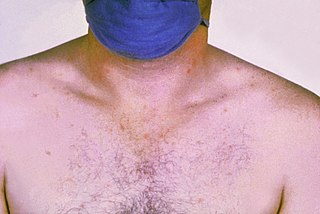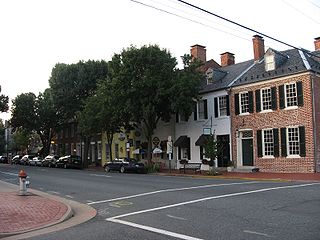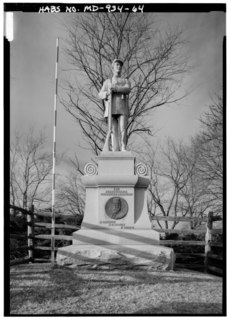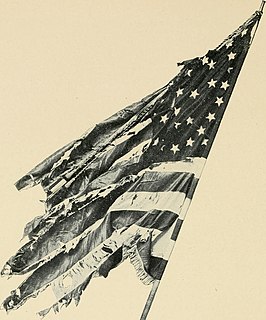History
After a call for volunteers in July 1862 by Andrew Curtin, Governor of Pennsylvania, the 134th Regiment was mustered in for nine months of service. The companies were from the following counties:
Most of the men had no prior military service. Some had served in the Mexican–American War, but many were fresh recruits. After being trained at Camp Curtin, they were moved to Washington D.C. on August 20, 1862, following the Confederate advance on the capital during the Northern Virginia Campaign. After one day at Washington, they were moved to Arlington Heights, where they engaged in drill and other duties. They joined a brigade with the 91st, 126th, and 129th Pennsylvania regiments, under the command of General Erastus B. Tyler. It was here that the organization of the regiment was completed. For the field officers, Matthew Quay of Beaver County was commissioned as colonel, Edward O'Brien of Lawrence County as lieutenant colonel, and John M. Thompson of Butler County as major.

The Mexican–American War, also known in the United States as the Mexican War and in Mexico as the American intervention in Mexico, was an armed conflict between the United States of America and the United Mexican States (Mexico) from 1846 to 1848. It followed in the wake of the 1845 American annexation of the independent Republic of Texas. The unstable Mexican caudillo leadership of President/General Antonio López de Santa Anna still considered Texas to be its northeastern province and never recognized the Republic of Texas, which had seceded a decade earlier. In 1845, newly elected U.S. President James K. Polk sent troops to the disputed area and a diplomatic mission to Mexico. After Mexican forces attacked American forces, Polk cited this in his request that Congress declare war.
Camp Curtin was a military training camp in Harrisburg, Pennsylvania, during the American Civil War.

The Confederate States Army (C.S.A.) was the military land force of the Confederate States of America (Confederacy) during the American Civil War (1861–1865), fighting against the United States forces. On February 28, 1861, the Provisional Confederate Congress established a provisional volunteer army and gave control over military operations and authority for mustering state forces and volunteers to the newly chosen Confederate president, Jefferson Davis. Davis was a graduate of the U.S. Military Academy, and colonel of a volunteer regiment during the Mexican–American War. He had also been a United States Senator from Mississippi and U.S. Secretary of War under President Franklin Pierce. On March 1, 1861, on behalf of the Confederate government, Davis assumed control of the military situation at Charleston, South Carolina, where South Carolina state militia besieged Fort Sumter in Charleston harbor, held by a small U.S. Army garrison. By March 1861, the Provisional Confederate Congress expanded the provisional forces and established a more permanent Confederate States Army.
On August 30, the 134th marched towards Manassas, Virginia, but arrived too late to participate in the Second Battle of Bull Run. The men returned to camp and were put in the defenses. On September 13, Tyler's Brigade, as part of the Third Division, V Corps, marched towards South Mountain in central Maryland. It arrived near Sharpsburg, Maryland, on the 18th, but had arrived too late to participate in the Battle of Antietam.

Manassas is an independent city in the Commonwealth of Virginia. As of the 2010 Census, the population was 37,821. The city borders Prince William County, and the independent city of Manassas Park, Virginia. The Bureau of Economic Analysis includes both Manassas and Manassas Park with Prince William County for statistical purposes.

The Second Battle of Bull Run or Battle of Second Manassas was fought August 28–30, 1862 in Prince William County, Virginia, as part of the American Civil War. It was the culmination of the Northern Virginia Campaign waged by Confederate Gen. Robert E. Lee's Army of Northern Virginia against Union Maj. Gen. John Pope's Army of Virginia, and a battle of much larger scale and numbers than the First Battle of Bull Run fought on July 21, 1861 on the same ground.

Maryland is a state in the Mid-Atlantic region of the United States, bordering Virginia, West Virginia, and the District of Columbia to its south and west; Pennsylvania to its north; and Delaware to its east. The state's largest city is Baltimore, and its capital is Annapolis. Among its occasional nicknames are Old Line State, the Free State, and the Chesapeake Bay State. It is named after the English queen Henrietta Maria, known in England as Queen Mary.
During the night of the 18th, the Confederate army withdrew into Virginia. Until September 30, the regiment remained near Sharpsburg and drilled. During this time, Colonel Quay was caught typhoid fever and O'Brien took command. In November, the regiment moved to Fredericksburg, Virginia, where it went into camp.

Typhoid fever, also known simply as typhoid, is a bacterial infection due to Salmonella typhi that causes symptoms. Symptoms may vary from mild to severe and usually begin six to thirty days after exposure. Often there is a gradual onset of a high fever over several days; weakness, abdominal pain, constipation, headaches, and mild vomiting also commonly occur. Some people develop a skin rash with rose colored spots. In severe cases there may be confusion. Without treatment, symptoms may last weeks or months. Diarrhea is uncommon. Other people may carry the bacterium without being affected; however, they are still able to spread the disease to others. Typhoid fever is a type of enteric fever, along with paratyphoid fever.

Fredericksburg is an independent city located in the Commonwealth of Virginia in the United States. As of the 2010 census, the population was 24,286, up from 19,279 at the 2000 census. The city population was estimated at 28,360 in 2017. The Bureau of Economic Analysis of the United States Department of Commerce combines the city of Fredericksburg with neighboring Spotsylvania County for statistical purposes.
In early December, Quay was forced to resign due to his disease and O'Brien was promoted to colonel, Thompson to lieutenant colonel, and Captain William H. Shaw to major. The 134th fought in the Battle of Fredericksburg on December 13, losing 14 killed, 106 wounded, and 19 missing. Despite his illness, Quay volunteered to serve as an aide to General Tyler throughout the battle, for which he would receive a Medal of Honor in 1888.
The regiment fought in the Battle of Chancellorsville from May 1 to 3 1863, on the left flank of the Union army. Total casualties were 48 men killed, wounded, and missing. The enlistments of the men expired soon after the battle, and the 134th was mustered out in Harrisburg on May 26, 1863.













